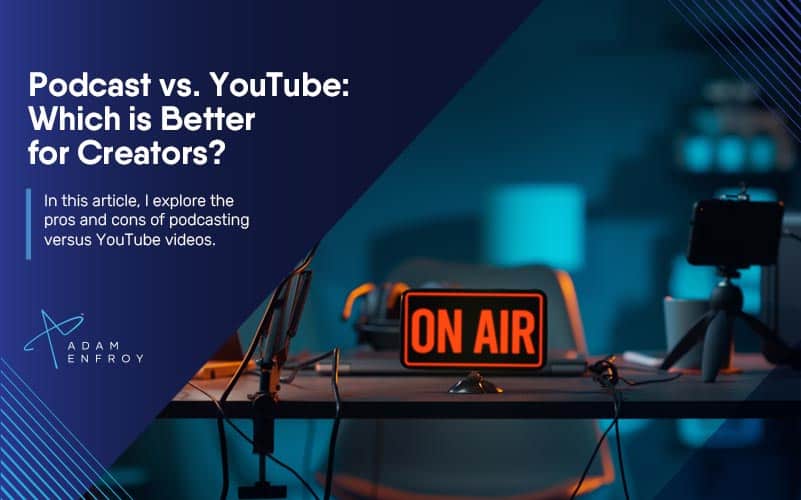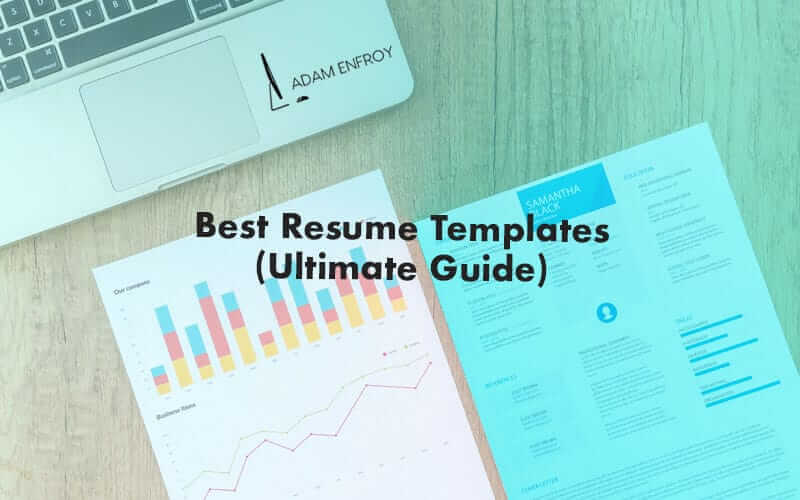Podcast vs. YouTube: Which is Better for Creators in 2024?

With nine of ten people discovering new brands through YouTube, this platform is one of the most popular ones for content creators.
This statistic shows the immense potential for success when launching a YouTube channel.
On the other hand, podcasting has become increasingly popular in recent years, with more and more people tuning in to listen to their favorite shows.
With its growing popularity, podcasting is becoming a viable way for content creators to reach an audience.
Understanding the differences between podcasting and YouTube videos can help content creators decide which platform best suits their needs.
In this article, I’ll explore the advantages and disadvantages of podcasting versus YouTube videos, helping you decide which is right for you.
Podcasts vs. YouTube: What’s the Difference?
Here are the main differences between podcasts and YouTube.
Advertising Opportunities
With YouTube offering monetization methods such as AdSense, making money through high-watched videos is well possible.
Moreover, with options like sponsorships, merchandising, brand collaboration, and custom campaign packages, there is a vast array of money-making opportunities.
You can do this via ads placed on your videos by advertisers who pay based on views or clicks.
As a publisher, YouTube also allows you to customize where ads appear and how often they show.
When it comes to podcasting, Apple Podcasts, Spotify, iTunes, Google Podcasts, and other podcasting platforms have taken an essential first step in allowing users access to specific content by set artists.
However, a system that’s both reliable and available to the public could be some time away.
If you want to make money from your own podcast, you must find sponsors or set up a donation page so your listeners can support your work.
Alternatively, here are a few other ways to monetize your podcast.
Audience Engagement
Regarding audience engagement, both platforms offer ways for creators to interact with their fans.
However, there are some differences.
As a video-sharing platform, YouTube users can engage with viewers through comments and shares.
Podcasting offers more direct interaction options, such as taking calls from listeners during the show.
While YouTubers can do this through YouTube live, it’s less common than it is with podcasts.
Content Format
YouTube content is typically visual and uses audio in addition to video footage.
In contrast, podcasts provide only an audio-based range without visuals.
Also, podcasts are usually longer than most YouTube videos.
They are ideal for people who prefer to explore a topic in-depth.
Let’s now explore each marketing channel in more detail.
Why Should You Choose Podcasting?
Podcasting has become one of the most popular forms of content for individuals and businesses.
All you need is quality microphone recording software, creative presentation skills, fascinating guests, and a unique perspective that resonates with listeners.
If you have these criteria, podcasting can be an ingenious and easy way to share your business’s knowledge with the world.
Podcasts are increasingly becoming a popular medium for entrepreneurs and business owners to connect with their audience and a great way to drive traffic and increase brand engagement.
Reach Your Target Audience Effectively
A podcast targeting specific demographics and groups can help you effectively reach your target audience.
One of the main benefits of podcasting is that people who tune into podcasts feel like you’re letting them into your world and onto something special.
It’s almost as if you’re having a conversation just with them.
This feeling of intimacy allows you to engage with them more effectively than if you were creating content for YouTube or another platform.
Plus, podcasts don’t require active listening to consume.
People can listen while doing other activities like commuting or exercising.
Capture Attention Easily
Another advantage of podcasting is that it allows potential followers to hear what you have to say without ever seeing you.
A podcast host can captivate the audience with their unique personality and style of delivering content.
It’s easy for people to get hooked if your podcast content resonates with them.
You can also provide different perspectives on topics your target audience may be interested in, encouraging them to subscribe and keep listening.
Finally, the top podcasting hosting platforms provide excellent tools for beginners and veterans in this industry.
Make It Professional Every Time
With a bit of effort, you can ensure all podcast episodes sound professional without muffled voices or sudden cuts.
Quality audio recordings will give your followers confidence in what you’re saying and create trust between yourself and your listener base.
It’s crucial to invest in good equipment that won’t disappoint you.
There are plenty of budget-friendly options available.
Also, find ways to make your podcast stand out so you can hook potential followers immediately.
Even slight differences, such as adding music or changing your speaking style, can make all the difference in capturing attention.
How To Create A Successful Podcast
There are a few crucial steps to creating a successful podcast.
Here are some of the most important ones:
- Mastering audio editing software
- Curating an exciting guest list that resonates with podcast listeners
- Selling listeners to tune into your show episodes
- Handling any potential copyright issues
- And much more.
Before starting a podcast, research the topics you plan to cover and the people who might be interested in them.
Listeners will want to consume not only excellent audio content but also topics that they care about.
Think about what kind of content would help them learn more about their interests or provide entertainment for their day-to-day lives.
Knowing Your Audience Is Key
Here are some key questions to ask yourself:
- What pain points is your audience dealing with?
- What solutions could you provide to them?
- Are there any topics they still need to explore that could interest your target audience?
- What unique insight can you provide that no one else has?
- How will your content benefit your listeners?
- Who are the experts in this field that could be guests on your show?
- Will you have a specific format for each episode?
Knowing your audience, needs, and interests is essential for creating a compelling podcast.
Don’t Underestimate Your Guest List
If interviews are part of your podcast plan, it’s important to curate an exciting guest list that resonates with listeners.
Researching potential guests who could provide great insights into topics relevant to your audience is critical.
It also means having a few backup interviews ready in case someone cancels at the last minute.
Also, note down any topics that arise during an interview.
Sometimes, the promise of further podcasts on a set topic with the same guest is enough to get subscribers for life.
Once you record your podcast, edit it, and have your episode ready for release, it’s time to find ways to market them online.
Various services can handle payment processing if you’re getting people to pay to listen.
Additionally, marketing through extensive live-streaming services can help build visibility for your show and garner new listeners over time.
Launching A Successful YouTube Channel
Let’s now dive deeper into how you can launch a successful YouTube channel.
Investing In A Quality Camera
As you scale up your professional YouTube channel, a professional-grade camera is a must.
Investing in good-quality cameras will give you an edge in terms of high-quality visuals.
You also get a higher chance of more prominent brands and networks taking notice of your YouTube channel.
Investing in a good camera doesn’t have to be expensive.
Even mid-range DSLRs can produce great results.
Professional-level cameras often come with manual controls which allow you to adjust settings such as shutter speed, aperture, and ISO according to your needs.
Your YouTube video content will have sharp colors and minimal noise (graininess).
If you are looking for an even higher level of quality, investing in a mirrorless or cinema-grade camera may be worth considering.
Using Quality Microphones
Having a good microphone is equally essential when creating videos for YouTube.
A poor audio file can ruin any video if viewers cannot hear your words as well as possible.
Investing in an external microphone allows you to capture voices much better than the built-in microphone on most cameras does.
Most cameras have one-directional mics which capture sound from one direction only.
In contrast, omnidirectional mics pick up sound from all directions evenly.
Depending on the video recording type, one might be more suitable than the others.
A good quality microphone can also help if you get into YouTube and podcasting (more on this later).
A professional vlog typically uses one microphone to capture the vlogger’s voice.
Podcasting generally utilizes two microphones – one for each speaker – even though it’s audio-only.
Overall, a good microphone will not only make your audio more enjoyable for listeners.
It will also give them less of a reason to be distracted and more likely to engage with your content.
Creating Good Lighting Setup
Lighting is vital in ensuring that your videos look professional and inviting for viewers.
Natural light is always preferred, but you can use artificial lighting instead of LED or ring lights if you don’t have access to natural light.
The latter is adjustable, allowing you to get the perfect lighting setup for every situation.
Different types of lights can create different moods and help bring out specific details that would otherwise go unnoticed without proper lighting setups.
Investing in a full lighting setup will be beneficial if you pursue a full-time YouTube career.
This setup can also include further lightboxes, reflectors, and diffusers.
Develop An Engaging Personality
One similarity between podcasting and vlogging is the importance of an engaging personality.
With an ever-expanding community of people tuning into your content, having an engaging personality that resonates with your target audience is crucial for a successful YouTube career.
Think about what sets you apart from other YouTubers.
Are you funny?
Sarcastic?
Serious?
Whatever sets you apart from other creators – make sure it shines through in your videos!
Being genuine and authentic will give viewers a reason to come back and watch more of your content.
Optimize Your YouTube Search Results
On any given day, over 500 hours of videos are uploaded every minute to YouTube.
Optimizing your videos for search results is crucial to stand out.
Start by doing keyword research to identify relevant terms people are searching for related to your topic or niche.
Doing so will put you ahead of the competition when it comes time to upload new videos.
Ensure those keywords appear prominently in your title, description, and video.
This data helps Google index your content appropriately so people can find it easily among all the other videos on YouTube.
You can also take advantage of YouTube’s algorithm by understanding the proper steps for SEO optimization.
This understanding helps you structure each video, so it gets found in searches.
Building Relationships With Other YouTubers
Building relationships with other YouTubers who have already established themselves on the platform takes time and dedication.
If done correctly, these relationships open up potential collaborations that help both channels grow and provide monetization opportunities.
It’s great to network with fellow creators who align with your brand values.
After all, you never know where these conversations could take you.
When building relationships, always lead with value.
For example, you could join an existing conversation and offer helpful advice for free.
As a result, you demonstrate your credibility and expertise in the industry, which will help build trust with other YouTubers.
The Benefits Of YouTube For Businesses
YouTube is one of the most popular websites worldwide, and it’s an excellent resource for businesses looking to increase their online presence.
One of the most significant benefits of using YouTube is that you can optimize your videos to appear in both YouTube and Google searches.
With an algorithm that can make videos more visible in both YouTube and Google searches, online business owners have a lot of opportunities to get their message out.
More people will be able to find your content, which could result in improved search rankings and an increase in website traffic.
To do this, use targeted keywords throughout your video titles and descriptions and associated tags so that your content appears when people search for relevant topics.
YouTube provides users multiple ways to monetize their content and earn money from views or watch time on the platform.
By opting into YouTube’s Partner Program, you can receive a portion of the revenue earned from those ads.
The potential for affiliate links or even monetizing content is excellent as well.
You can earn money through affiliate links associated with products featured in videos or mentioned during them.
Make sure to disclose affiliate relationships clearly within FTC guidelines.
What’s the Best Platform for Your Business?
The answer is that it depends on your needs.
Podcasts provide a highly personal form of communication that you can do with minimal equipment.
Additionally, podcasts allow listeners to get to know the host in a more intimate setting than other forms of media.
When comparing blogs vs. podcasts in terms of intimacy, podcasts generally win.
Listening to someone’s voice directly is much more intimate than reading their words in a blog post.
You can connect strongly with your audience and make them feel part of something bigger than themselves.
The downside is that there’s no visual element, so you must rely on your audio quality and content to keep listeners engaged.
YouTube has become one of the most popular video-sharing platforms.
This website allows businesses to easily create videos without needing expensive equipment or expertise in video editing software.
Videos are more engaging than other forms of content.
You can use visuals like graphics, animations, or live footage to draw people in and keep them watching until the end.
The downside is that video production takes longer than podcasting and requires more resources (both time-consuming and money-wise).
Knowing the pros and cons of both platforms can help you decide which is best for your business.
What It Takes To Create Captivating Shows
If you want to capture the attention of your viewers and have them come back for more, it’s essential to develop captivating shows that are interesting and engaging.
Here are the primary considerations to keep in mind when creating content.
Have The Right Equipment
The right equipment is crucial in the podcast vs. YouTube debate.
Podcasts require minimal equipment to get started, but you’ll need more robust audio and video gear if you plan to produce high-quality videos.
In any case, quality equipment is vital.
Find The Right Guests
If you’re not going solo, one of the first steps in creating great audio/video productions is finding the right guest stars that your viewers can relate to.
Do your research on potential interviewees and ensure that you bring in people with interesting stories or perspectives that can add value to your show.
Ask Thought-Provoking Questions
Creating popular podcasts or YouTube channels involves asking questions that generate thought-provoking answers.
You want the conversation to be engaging and informative, so ask questions that will draw out exciting stories from your guests and elicit meaningful answers.
Ask open-ended questions encouraging people to share more than just yes or no answers.
At the same time, don’t be afraid to ask more profound questions that probe into the stories and topics you’re covering.
Marketing Tactics
Once you have created a captivating show, it’s time to think about how best to market it on multiple platforms.
Use social media sites like Facebook, Twitter, Instagram, or even Reddit to share the news.
Utilize hashtags, use influencers for promotion, and post sneak previews of an upcoming podcast episode or video via your social media platforms.
There are many tactics available for boosting visibility online.
Maximizing Your Reach
As a content creator, a strategy that often works is repurposing content from one platform to another, creating a video podcast.
By understanding the unique requirements of podcasting and YouTube posting, you can create a successful strategy to draw in and engage more viewers on both channels.
As I’ve discussed, both platforms have pros and cons, so knowing how to use each effectively is essential for maximizing your reach.
For example, podcasting makes consuming longer content easier for people on the go.
If you can hook your audience with compelling titles and hooks in each episode, they’re more likely to stay tuned in until the end!
When creating an audio show, post-show notes and transcripts of the episode so that those who don’t have access to audio can still follow along.
On the other hand, YouTube posting requires more than just uploading the visual content and forgetting about it.
Intriguing descriptions, attractive thumbnails, and excellent video editing all draw viewers in.
The key is understanding how each platform works so that you can optimize your videos accordingly.
This way, you can maximize engagement across both platforms without investing too much extra effort in the type of content itself.
Top Optimization Practices To Consider
Here are some top optimization practices for podcasts and YouTube videos.
Leverage Influencers To Reach Your Target Audience
Working with influencers on YouTube is an excellent way to reach your target audience.
By partnering with an influencer with expertise in your niche or product/service area, you can gain valuable insights into what content marketing strategies resonate best with viewers.
You also get access to their existing fan base without having to do much work.
However, finding the right influencer is critical here.
You need someone who understands your brand ethos and values and whose audiences align with yours.
Optimize For SEO
Whether you choose podcasts or YouTub as your route to marketing your business, optimizing your content for SEO is another vital consideration.
Doing so will increase its chances of being seen by searchers and generate more leads for your business.
Optimizing titles, descriptions, and tags with relevant keywords related to your niche will help Google understand the context of what you’re creating and consequently recommend it when someone searches for it online.
Potential customers will be organically exposed to your product or service, thus increasing your visibility online.
Wrap Up.
Podcasts and YouTube allow you to create content that a broad audience can hear, see, and enjoy.
With many benefits these channels offer, you can effectively market your business and drive more leads.
No matter which distribution channel you choose to leverage, providing value in the content you create should be your priority.
Optimizing such content for your target audience will ensure the right people see your message.
Further reading on AdamEnfroy.com: If you can’t decide which platform is best, why not learn how to start a podcast on YouTube?





